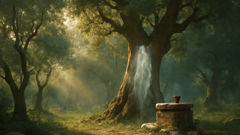Introduction
In the cool hush beneath an ancient canopy, where sunlight braided itself through leaves and the ground remembered centuries of footfall, the dryads stirred. Their presence was no loud proclamation; it was a syllable of moss, the nearly audible sigh of sap, the tremor of a root answering rain. Greeks of old walked in such groves and felt, even if they could not always name it, an intelligence that belonged not to any single person but to the living architecture of the forest. Dryads—sometimes called the lesser nymphs of trees—were named for trees themselves, and hamadryads were more particular still: bound to one trunk, one life, sharing fate with bark and cambium. To cut down a hamadryad's tree was to harm a life as surely as a wound to the chest. Stories told of lovers who fell asleep within walnut branches and awoke to find themselves cradled by—some said embraced by—a benevolent spirit; of shepherds who offered wine or bread at the foot of an oak to placate the unseen tenant within; of cities whose founders planted sacred groves to ensure favor and fertility. These tales were never simply about fantasy. They were a language for a culture's relationship with its environment, an ethic embodied in song and sacrifice. The dryads taught restraint and reverence, reminding mortals that landscapes are woven of reciprocity: the tree giving shade and fruit, the people offering protection and ritual. As you read, imagine stepping foot into such a grove: the damp scent of earth, the distant ring of a temple bell, the whisper of leaves like a chorus tuning itself. This story will trace origins, myths, rites, and echoes of the dryads and hamadryads across the centuries, following the threads that tie human memory to the slow, patient life of trees and asking what it means, even now, to share our fate with another living thing.
Roots and Breath: Origins and Nature of Dryads
The origins of dryads and hamadryads are braided into the very way ancient Greeks sought to explain life that seemed to move with a consciousness different from their own. In Homer and Hesiod one finds hints and etymologies: 'dryad' derives from the Greek drýs, meaning oak, though the term broadened to include many types of trees. Hamadryads—ἁμαδρύας in classical spelling—carried an even stricter meaning: a spirit whose life was identical with a tree's. The life of the nymph and the life of the tree were not adjacent but one and the same; when the tree withered, the hamadryad's soul, whatever form it wore, left the world. This belief is at once simple and profound. It articulates a vision in which living things are not isolated actors but participants in intimate ecological contracts.

In the earliest rural communities, where the pulse of seasons dictated survival, trees were living repositories of time. An olive tree could be tended for generations; a cypress could mark a family plot. The ancients imbued these trees with personhood as much to explain their steadfastness as to propose a moral relation between human action and natural consequence. Offerings—tiny votive cakes, libations of wine, sprigs of herbs—were left by the roots. In a cultureless by all but time and memory, such gestures create a social contract: respect the tree and you may ask it for fruit, shade, shelter. The very language of offerings suggests reciprocity rather than dominance. In recorded myth and in the thin shards of local custom, priests or household heads might consult the will of a grove through minor rites, interpreting rustlings and the behavior of birds as signs. It is possible to think of the dryads as an anthropomorphic way to encode ecological stewardship—an ancient law disguised as myth.
Yet this is not to domesticate their strange wildness. Dryads could be capricious. Some tales speak of nymphs who would mislead hunters, leading them in circles until they were humbled or exhausted; others tell of nymphs who offered prophetic dreams to those whose hearts were open. A hamadryad attached to a venerable oak by a temple might appear in the dreams of priests, asking that a particular branch be left uncut for the sake of a coming festival. These stories display a range of temperaments—a crucial reminder that personifying nature does not necessarily make it benign. Like any living being, the tree-nymphs possessed habits and preferences, and offenders might be punished with failing crops, barrenness of flock, or sudden illness. Grecian law and custom ultimately reflected a practical ethic: when a grove was declared sacred, taking from it required ritual permission; transgression could bring social as well as supernatural consequences.
Literary sources preserve snapshots: Theocritus and Callimachus mention tree nymphs in passing; later Roman accounts often merge or repurpose Greek ideas. But the crux of the dryad myth is preserved more fully in local legend and cult practice. In Arcadia, for instance, where mountains and forests shaped life, women performed rites to honor the spirits of trees during seasonal festivals. Young maidens might range through groves, offering songs and braided garlands. The choice to place female figures as guardians of trees is meaningful. Trees are rooted, passive in one sense, yet their slow growth and persistence embody a feminine endurance that ancient poets and storytellers invested with tenderness and respect. Dryads are not merely fairy-tale attendants; they are embodiments of a relationship between human communities and the slow timescales of other living things.
Ecologically speaking, the hamadryad concept is singularly acute. Where modern ecology uses the term symbiosis to describe mutual dependencies, the ancients used story to suggest the dire consequences of severing certain vital links. A hamadryad's demise via deforestation could be read as an allegory for the cascading consequences of environmental damage: remove the old tree, and you remove shade for seedlings, nesting sites for birds, moisture retention for the soil. The old stories dramatize this with moral force. Consider the grove where a hamadryad is said to have perished because a farmer, desperate in a lean year, cut down an ancient oak. Afterward, the harvest failed, and the family fell into sickness. The community recognized the pattern long before modern science formulated it: the loss was not merely aesthetic but functional and spiritual.
Musically, the presence of dryads was marked by rhythms of the seasons. Spring brought the quickening of buds and sighs of reawakened sap; midsummer braided lullaby and lull in hot noon light; autumn carried the sound of leaves letting go in a quiet chorus. Poets and travelers preserved these imageries in song and verse, creating a lexicon of sensory details now invaluable for reconstructing ancient practices. Those who wrote often described the dryad's touch as cool, like moonlight on bark, or warm, like a summer breeze through new leaves. Such expressions, while poetic, encode experiential knowledge: the contrast between sun and shade, the way a tree's microclimate supports life beneath it, the small ecological pocket a single oak can create.
Beyond the pastoral, certain trees had cultic prominence. The oak of Zeus and the laurel of Apollo became centers where politics, religion, and ecology intersected. When city-states or sanctuaries claimed groves, the dryads associated with them were indirectly woven into civic identity. A polis might enact laws protecting sacred groves; a temple might station custodians specifically to watch and tend these places. In some cases, invaders who damaged groves were punished by exile or fines, preserved by custom if not always by centralized law. The very act of protecting a tree became a civic performance, a reminder that human communities must nurture what will outlast them. To honor a dryad was thus to honor continuity itself.
The figure of the dryad also served as a moral interlocutor in tales that tested human character. A common motif recounts a traveler who disregards a grove's sanctity and suffers misfortune, contrasted by a humble shepherd who shows kind patience and is guided to water or shelter by the grateful dryad. These narratives did not depend on miraculous intervention alone; they celebrated an ethic of care. The shepherd's reward is often practical—a fresh spring, a bounty of fruit—framed as a reciprocation for modest, respectful acts. By couching practical resource management within the language of myth, communities reinforced practices that favored long-term survival.
Finally, consider the anthropology of these beliefs. To invest trees with personalities and fates is to create a moral ecology, a living jurisprudence where the rights of nonhuman beings are considered at least indirectly. Dryads and hamadryads provided a vocabulary for limits: there are places one does not enter, branches one does not take, times of year when the grove must be left in peace. Such constraints are familiar to modern conservationists, and the parallels are too striking to be accidental. The old gods and spirits taught a kind of land stewardship through myth, a cultural form that shaped behavior more effectively than edicts because it appealed to shared values and imaginings that bound communities together.
This portrait of dryads is intentionally expansive: they are simultaneously poetic interpolation, religious actor, ecological metaphor, and social device. Their stories encourage us to think about how human cultures encode sustainable behaviors, and how myth can function as a long-lived ally to the living world it seeks to protect. In the coming sections we will move from etymology and cult into the more intimate stories—of lovers and grief, of curses and protection—that made dryads memory-carriers for entire landscapes.
Stories and Rites: Tales of Love, Loss, and Law
If the first section sketched the contemplative, ecological frame of the dryad legend, this one draws the stories close to the hearth of human feeling. Tales of dryads are often intimate and small in scope—an act of kindness rewarded, a transgression that invites penance—but through their repetition they become repositories of values and law. Consider the classic narrative pattern that reappears in multiple variants across the Hellenic world: a mortal falls into companionship with a dryad, either by chance or by intent; the relationship is fraught with the tension of mortality, for the dryad's existence is inextricably tied to the tree; some unions end in blessing, others in grief. These stories explore what it means to love what is not wholly ours.

One well-known type of tale concerns a lover who wakes within the arms of a tree-guardian. A shepherd, exhausted after a long drought, may fall asleep beneath a plane tree and awake to find a gentle presence tending his brow, leaving a crown of leaves upon his head. He gains, in the course of the tale, a boon—a stream appears nearby, his flock prospers—and the dryad's favor is sealed. Yet the same motif transforms into tragedy when the demands of human life conflict with the life of the tree. When a hamadryad's tree is cut by necessity or greed, the lover—if mortal—must watch helplessly as their beloved's life ebbs with the bark. Such stories illustrate a moral: love demands respect for boundaries. You cannot possess the living world without consequence.
Legal customs grew around these tales. Some city-states had statutes against wanton tree-felling. In instances where wood was required for shipbuilding or construction, officials might perform rituals to buy or procure timber with consent; priests or civic magistrates could declare a grove open for limited use only after rites had been performed. The procedural steps—making libations, addressing the spirit by name, pledging restitution—worked as both spiritual and social mechanisms to avoid the kind of errant violence that myth portrays as calamity. It is no accident that stories about hamadryads often include negotiations or attempted reconciliations: narratives dramatize the need for negotiated resource use in a shared landscape.
Another cluster of stories turns on justice. A hamadryad whose tree was destroyed could call upon gods or men to make recompense. The consequences in myth are sometimes immediate—a blight upon the harvest, a plague of locusts—but at other times the punishment is poetic and focused. A community that refuses to answer the grief of the grove may find its law itself undermined: judges lose their authority, oaths become hollow, contracts fail. In such narratives, honoring the living components of the landscape is not merely an act of piety but the backbone of social order. The moral is not narrowly religious; it is societal: communities depend on a web of trust that extends beyond human actors.
Rituals associated with tree spirits varied widely from place to place. In some islands of the Aegean, sailors might offer a prayer to a shore-side grove to ask protection for a voyage; inland, farmers might tie ribbons or small tokens to branches to mark vows or hopes. The practice of binding cloths—an act recognizable in many cultures—served as a visible sign of an exchange: a wish made, a pledge bound, a request given form. These tokens, left fluttering in the wind, created a landscape of memory, a mosaic of human stories hung on living trunks.
Certain myths highlight the politics of groves. It was not unknown for city-states to claim prophetic groves as their property; sanctuaries could own olive groves whose oil supplied sacred lamps. The control of such resources could bring wealth and influence, and myths sometimes portray this dynamic in tragic light when sacrilege occurs for private benefit. The dryads, then, become symbols of contested resources—guardians who align with communal wellbeing rather than elite extraction. Stories that pit private greed against communal ritual dramatize the broader tension between short-term gain and long-term survival.
The tragic strains of the dryad myths are perhaps the most memorable. A favorite motif recounts a hamadryad who dies when her tree is felled by a thoughtless child or by an invader who wishes to erase local customs. The child's remorse becomes a cautionary tale; the invader's guilt marks the tale with moral clarity. In one regional variant, a family that cuts sacred wood must undertake a decade of caretaking—water the groves, plant new seedlings, feed the birds. The remedy is restorative, not merely punitive: it acknowledges harm but offers a path toward reparation. This restorative impulse is an important ethical note in ancient practice that resonates with modern approaches to environmental restitution.
Stories also explore boundary crossings. Nymphs sometimes preside over thresholds: between wild and cultivated land, between sacred and profane time. Festivals that involved processions from a city to a grove enact a liminal crossing: citizens temporarily enter a place where different rules apply, where the ordinary commerce of the polis yields to seasonal ritual. In these liminal spaces, the dryads' presence legitimizes a temporary suspension of daily law in favor of a ritual order that resets social ties. Thus groves function as regulatory landscapes, places where community identity is rehearsed and renewed.
An enduring theme in these tales is the idea of listening. Those who are attuned to the sounds of the grove—its birds, its insect chorus, the whisper of leaves—are more likely to hear the dryad's voice. The voice may be metaphorical; but tradition insists on care: tending a young tree, refusing unnecessary burning, leaving corridors of forest to preserve wildlife. Through story, the ancients encoded a practice of attention to nonhuman life that functioned as an early ethic of stewardship. Dryads ask not for dominion but for reciprocity: an exchange that honors continuity.
The ritualistic and narrative tapestry around dryads also seeds modern reflection. When contemporary writers and conservationists look back at these myths, they often find a humble wisdom about living in balance with longer-than-human rhythms. The tales of love, loss, and law we have inherited are not only quaint lore. They are instructive parables about mutual dependency and the ethical necessity of caring for what sustains us. In reading them today, we confront familiar dilemmas: how to weigh immediate needs against generational survival, how to negotiate the rights of communities versus the demands of development, and how to listen to the living world in a time of ecological crisis.
Ultimately, the stories and rites of dryads and hamadryads are both mirrors and tools. They reflect the ancient world's care for place and provide ways for people to live in intimate relationship with their environment. As the next part of our narrative will explore, these myths have left traces in later art, literature, and even legal thought, proving that the voice of the grove, once voiced, tends to endure in human culture long after the trees themselves turn to story.
Conclusion
The myth of the dryads and hamadryads is not merely a relic of fanciful imagination; it is an old, persistent argument for a way of living that recognizes the personhood of places. In the myths, trees are not inert materials to be used up; they are kin, witnesses, and sometimes victims. The ancients encoded an ethic of reciprocity and care: leave a sprig, pour a libation, spare an old tree, and in return receive shade, fruit, stories, and the steadying presence that only long-lived beings can provide. Today, when entire forests face mechanized removal and ecological balance teeters, those old stories gain a new urgency. They offer a moral vocabulary for conservation, a cultural precedent for laws and rituals that protect groves and insist on reparation when harm is done. To remember the dryads and hamadryads is to remember that human lives are enmeshed with other forms of life whose rhythms exceed our calendars. It is a call to stewardship that asks us to cultivate patience and to accept limits that are not arbitrary but necessary for shared flourishing. If we listen—truly listen—to leaf and root, to the long, slow pulse of tree and grove, we hear the same counsel the ancients passed down through tale: tend what gives you life, and honor it with acts worth of its endurance. In doing so, we join an unbroken lineage of listeners stretching from antiquity to the present, a community that keeps faith with the living world by telling stories that make us better caretakers of the earth we inhabit.













